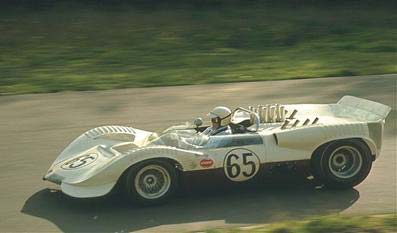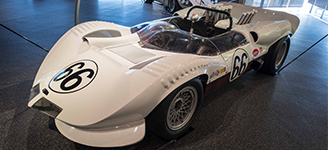Chaparral 2
 The Chaparral 2 was the first Chaparral car designed by Jim Hall and Hal Sharp and the first built in Midland. During the 1963, 1964, and 1965 road race seasons, versions of the car notched-up 22 wins in 39 races against world-class international competition.
The Chaparral 2 was the first Chaparral car designed by Jim Hall and Hal Sharp and the first built in Midland. During the 1963, 1964, and 1965 road race seasons, versions of the car notched-up 22 wins in 39 races against world-class international competition.
The Chaparral 2 boasted a new approach to frame design. The semi-monocoque chassis structure was inspired by modern aircraft design and was modeled from fiberglass reinforced plastic. Since the engine was mounted just behind the driver, the car’s designers were free to shape a low, sleek front end fitted with a V-shaped lip spoiler. This design kept the car from lifting at high speeds. In 1964, at Laguna Seca, the Chaparral 2 introduced an “automatic” transmission, which eliminated the clutch pedal and freed the divers left foot to operate the brake while keeping to other foot on the throttle.
Although the Chaparral 2 never had a wing, if there was one signature feature that the Chaparrals developed over time, it was the tall, suspension-mounted, driver-adjustable “flipper” wing. Hall and four GM engineers patented the idea and used it on the 2E and 2G Can-Am roadsters of 1966-1968 and on the 1967’s 2F endurance racing coupe
“I’ve heard [Jim Hall] say that the big advantage of the automatic transmission is that it lets the Chaparral driver use his free hand to wave at the other drivers as he passes them!”
-Roger Penske, joking about Chaparral’s innovative automatic transmission
Engine: Chevrolet aluminum small- block 318-327 – cubic-inch V-8
Horsepower: 415-460 at 6,000-6,800 rpm
Carburetion: 4x twin-throat Weber
Transmission: Initially, Colotti Type 376 4-speed; from May 1964, Chaparral “automatic”
Bodywork: Fiberglass front, doors and rear sections
Cooling: Initially, dual-core radiator mounted vertically at front, and oil cooler with air intake in passenger door; later versions used a Corvette radiator at low angle, and oil cooler with air intake in rear body section.
Aerodynamics: In October 1963, snowplow front air dam, 1964, reshaped nose and added rear spoiler
Chassis: Fiberglass semi-monocoque; locally reinforced with honeycomb; steel mounting
Wheels: First appearance of Chaparral 2-piece bolted, adjustable width, spoked pattern, cast magnesium.
Tires: Front 5.50 x 15, rear 6.50 x 15 initially; progressively widened to 9.20 x 15 front and 12.00 x 15 rear; Firestone
Brakes: Solid discs, Girling calipers
Suspension: Front: double wishbone with coil-over shock absorbers, anti-roll bar, forged uprights; Rear: twin trailing arms, reverse lower A-arms, single top links, coil-over shock absorbers, anti-roll bar, cast uprights
Dimensions: 91-inch wheelbase, 158-inch length, 68-inch width, 58-inch front track, 54-inch rear track, 33.75-inch height, 3.5-inch ground clearance
Average Weight: 1,510 pounds, dry




